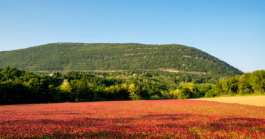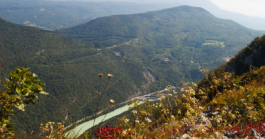The territory is much more than simple geography; it is an open book of wisdom, a testimony to the interconnection of all things.

Mt. Sabotino

Mount Sabotino rises 609 meters a.s.l. North East of Gorizia. It includes two smaller sections 507 to the north and 535 to the south, called San Valentino, with which it forms a short chain with a north-west southeast orientation. Its elongated configuration is common to two other mountains that overlook the Isonzo River: Monte Santo in the North, San Gabriele in the East. In these places, since the last glaciation (15-20 thousand years), a considerable biodiversity has been developed: to date 680 botanical species have been classified, 25 of which belong to Orchidaceae (2 of which are very rare).

Its slopes have different characteristics, not just orographic, and the crest line between West and East until the independence of Slovenia separates two vegetable groups. The northern part, rough and sloping down steeply towards the Isonzo river, houses alpine origin species (northern migrants) such as the hop hornbeam and the common hornbeam. The southern part, sloping towards Gorizia and covered by a layer of clay soil (the Ponca), houses sub-Mediterranean species (southern migrants) or Illyrian-Karstic such as: oak, durmast oak, holm oak, iris, illyrica.
The territory is much more than simple geography; it is an open book of wisdom, a testimony to the interconnection of all things.

Mt. Sabotino

Mount Sabotino rises 609 meters a.s.l. North East of Gorizia. It includes two smaller sections 507 to the north and 535 to the south, called San Valentino, with which it forms a short chain with a north-west southeast orientation. Its elongated configuration is common to two other mountains that overlook the Isonzo River: Monte Santo in the North, San Gabriele in the East. In these places, since the last glaciation (15-20 thousand years), a considerable biodiversity has been developed: to date 680 botanical species have been classified, 25 of which belong to Orchidaceae (2 of which are very rare).

Its slopes have different characteristics, not just orographic, and the crest line between West and East until the independence of Slovenia separates two vegetable groups. The northern part, rough and sloping down steeply towards the Isonzo river, houses alpine origin species (northern migrants) such as the hop hornbeam and the common hornbeam. The southern part, sloping towards Gorizia and covered by a layer of clay soil (the Ponca), houses sub-Mediterranean species (southern migrants) or Illyrian-Karstic such as: oak, durmast oak, holm oak, iris, illyrica.
Email: info@castelsanmauro.it
Tel: +39 328 9158033
nihil opus
© 2022 | CASTEL SAN MAURO di Manuele Mauri - P.IVA 00549350312 | Design e comunicazione: Leonardo Lenchig @ graphicopera.it | Privacy Cookie Policy
Email: info@castelsanmauro.it
Tel: +39 328 9158033
nihil opus
© 2022 | CASTEL SAN MAURO di Manuele Mauri - P.IVA 00549350312 | Design e comunicazione: Leonardo Lenchig @ graphicopera.it | Privacy Cookie Policy